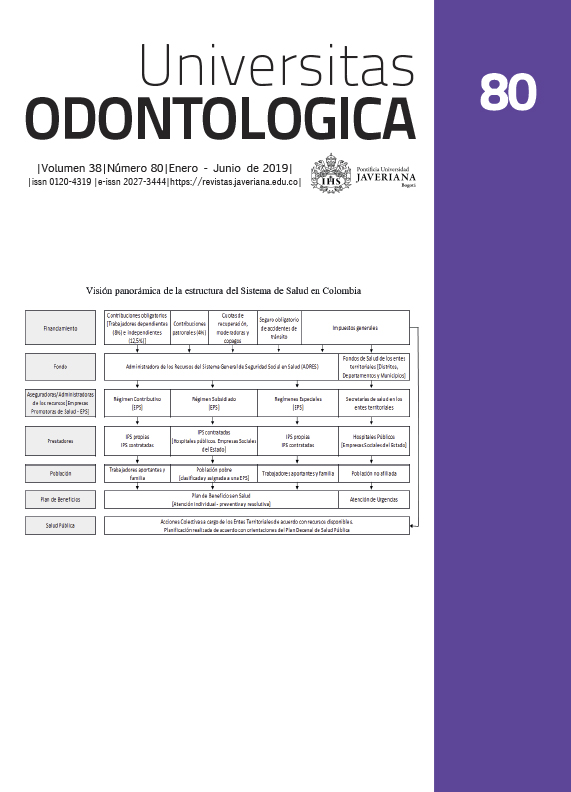Abstract
Background: Radiographic examination in upper molars is often deficient in order to diagnose abnormalities in the root canal system and to be able to choose the ideal treatment. Description of the case: This article shows the clinical case of a second right upper molar with symptomatic irreversible pulpitis. An accessory root on the palatal is observed in a radiographic examination. A therapy of the canal was carried out with ProtaperNext ® and the sealing was made by cold lateral condensation with ultrasonic condensation. Conclusión: It is very important to know the root canal system morphology of the tooth to be treated in order to offer the patient an adequate treatment.
2. Baratto-Filho, L.F. Fariniuk, E.L. Ferreira, J.D. Pecora, A.M. Cruz-Filho, M.D. Sousa-Neto Clinical and macroscopic study of maxillary molars with two palatal roots Int Endod J. 2002; 35: 796-801.
3. Ferreira CM, Moraes IG, Bernardineli N. Three-rooted maxillary second premolar. J Endod. 2000; 26: 105-6.
4. Velmurugan N, Parameswaran A, Kandaswamy D, Smitha A, Vijayalakshmi D, Sowmya N. Maxillary second premolar with three roots and three separate root canals-case reports. Aust Endod J. 2005 Aug; 31(2): 73-5.
5. Libfeld H., Rostein I Incidence of four-rooted maxillary second molars: Literature review and radiographic survey of 1,200 teeth. J Endod.1989; 15(3): 129-31.
6. Chi-Tsung W, Shin-Chie W. Bone Morphogenetic Protein-4 rs17563 T/C Gene Polymorphism with Radix Entomolaris of Mandibular First Molars in the Taiwanese Population. J Med Sci. 2013; 33(2): 61-5.
7. Christie WH, Peikoff MC, Fogel HM. Maxillary molars with two palatal roots: a retrospective clinical study. J Endod. 1991; 17: 80-4.
8. Barros DB, Guerreiro Tanomaru JM, Tanomaru-Filho M. Root canal treatment of three-rooted maxillary second premolars: report of four cases. Aust Endod J. 2009 Aug; 35(2): 73-7.
9. Vertucci FJ. Root canal anatomy of the human permanent teeth. Oral Surg. 1984; 58(5): 589-99.
10. Hartwell G, Bellizzi R. Clinical investigation of in vivo endodontically treated mandibular and maxillary molars. J Endod. 1982 Dec; 8(12): 555-7.
11. Sánchez-Salas OI, Jiménez-Valdés BI, Gómez-Pizano E. Primer molar superior con dos raíces palatinas: reporte de un caso. Rev Endod Actual. 2014; 9(1): 16-20.
12. Gulabivala K, Aung TH, Alavi A, Ng YL. Root and canal morphology of Burmese mandibular molars. Int Endod J. 2001 Jul; 34(5): 359-70.
This journal is registered under a Creative Commons Attribution 4.0 International Public License. Thus, this work may be reproduced, distributed, and publicly shared in digital format, as long as the names of the authors and Pontificia Universidad Javeriana are acknowledged. Others are allowed to quote, adapt, transform, auto-archive, republish, and create based on this material, for any purpose (even commercial ones), provided the authorship is duly acknowledged, a link to the original work is provided, and it is specified if changes have been made. Pontificia Universidad Javeriana does not hold the rights of published works and the authors are solely responsible for the contents of their works; they keep the moral, intellectual, privacy, and publicity rights.
Approving the intervention of the work (review, copy-editing, translation, layout) and the following outreach, are granted through an use license and not through an assignment of rights. This means the journal and Pontificia Universidad Javeriana cannot be held responsible for any ethical malpractice by the authors. As a consequence of the protection granted by the use license, the journal is not required to publish recantations or modify information already published, unless the errata stems from the editorial management process. Publishing contents in this journal does not generate royalties for contributors.



